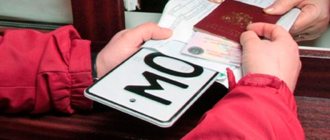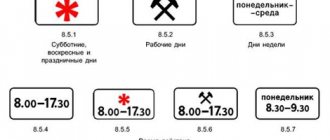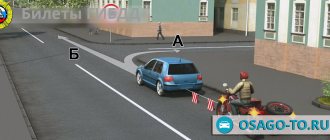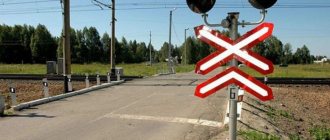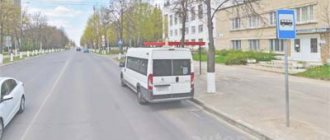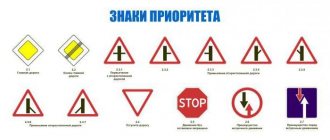Purpose
This sign and its meaning are given in clause 4.5.1 of the traffic rules; the picture on it depicts a person walking against a blue background. A similar sign marks the end of the zone, its difference is the presence of a red line. Regulatory authorities regularly update current rules. This happens with the aim of improving them and better meeting the needs of road users - motorists and pedestrians.
Sign 4.5.1 “Pedestrian path”
Recently, the number of motor vehicles in the urban environment has been increasing. In big cities they are trying to combat this by installing paid entrance to the central areas of the city or paid parking. Often pedestrian paths on the sidewalk are designated to protect architectural monuments.
What road sign indicates “Pedestrian path”
The pedestrian path is marked with a mandatory sign 4.5.1 of the Russian Federation Traffic Regulations. The sign is made in the shape of a blue circle. In the center of the circle there is a characteristic, almost universally recognizable, walking silhouette of a white man.
For better visibility, the sign is made using reflective materials. To produce the sign, galvanized steel with a thickness of 0.8-1.2 mm is used. The diameter of the sign is 700 mm.
Photo of the sign
This sign is usually installed in places where it is necessary to restrict the movement of vehicles and ensure the safety of people. These can be residential areas, recreation areas, parks, etc.
Are vehicles allowed on sidewalks or pedestrian paths?
Current traffic regulations provide for certain exceptions to the rules. Cyclists are allowed to enter the marked area, provided that there is no designated area near the edge of the sidewalk that allows them to ride along the edge of the sidewalk. If special services are forced to carry out repair work in an appropriate place, vehicles belonging to them have the right to pass through them. Persons driving cars or trucks must remember that:
- You can enter the area for pedestrians only if there are no other options;
- the pedestrian retains the priority right to move along the marked area. But, given the slowness of freight transport, it is necessary
- the vehicle can move as slowly as possible.
Similar rules apply to bicycle paths.
Is a sidewalk part of the road or not: definition and traffic rules
A pedestrian is the least protected participant in road traffic, and therefore requires additional protection. This consequence was realized through the allocation of a special pedestrian zone, the purpose of which is to ensure the safety of people. To determine the regulatory provisions of the traffic rules, you need to establish: what the sidewalk is and what it means for pedestrians.
What is a sidewalk
The sidewalk is a special area that is designated for the movement of pedestrians and cyclists. Expensive – this is the part of the coating intended for the movement of vehicles. It may consist of:
- tram tracks;
- dividing structures;
- roadsides;
- sidewalks.
That is, according to traffic regulations, the sidewalk is part of the road. The pedestrian zone must be separated from the roadway either by a green canvas at least 1 meter wide or by a concrete curb. The fencing is designed to prevent the risk of soil erosion and shedding. The curb also helps reduce the degree of destruction of the road surface.
What signs indicate the sidewalk?
The traffic rules do not provide separate signs for the sidewalk. This pedestrian element is marked with pedestrian zone designations, of which there are only three:
- sign 4.12. Its purpose is to allocate a lane where traffic is strictly permitted for mopeds or bicycles;
- sign 4.13. Placed in places where only pedestrians can move - no additional vehicles;
- sign 4.14. The meaning of this sign determines the areas where both cyclists and pedestrians can move.
In most cases, sidewalks are not marked with signs, so pedestrians and other road users should be aware of the visual signs that identify such an area.
How to set the width of the sidewalk
The size of the sidewalk depends on the intensity of pedestrian traffic in a particular area. The more people walk in one hour, the more lanes will be allocated for them:
- one track, if the intensity does not exceed 50 people per hour in both directions;
- two demarcation strips, if we are talking about more populated areas, in which from 50 to 1 thousand people move every hour;
- An additional lane is allocated for every one thousand people.
The minimum width is defined in the traffic regulations and is 1 meter. If there are several lanes, the lower limit is 0.75 meters. There is no maximum set, but there are recommended parameters. They are approved taking into account the type of street: highway, residential, industrial and warehouse areas, for office purposes, etc.
What are the prohibitions and permissions?
A sidewalk is an element of the roadway, the purpose of which is to ensure the unhindered movement of pedestrians, therefore driving on this section without an adequate reason implies the collection of a fine from the driver. To prevent prosecution, you need to take into account a number of rules.
In accordance with the general provisions of the traffic rules, the movement and parking of vehicles on the sidewalk is prohibited, with some exceptions that apply to certain categories of vehicles: working vehicles of road services and vehicles delivering goods to the place of sale. In all other cases, it is not allowed to use the pedestrian area for movement.
Even in the event of an accident, when the roadway is blocked, it is prohibited to drive around the scene of the accident on the sidewalk. Car parking in this zone is allowed only if there is a 6.4 sign and in specially equipped parking areas.
As for riding a moped on the sidewalk, it is permissible, but only if there is a permit sign. If a lane is designated specifically for these vehicles, then a pedestrian can use it only in the absence of a special path.
What is the fine?
In accordance with the current legislation of the Russian Federation, parking in the wrong place is punishable by a fine in the amount of 1 thousand rubles. In this case, the car must be towed to the impound lot. In such a case, the driver must be prepared to pay in addition for storage and evacuation services for vehicles. So, for the work of a tow truck you will have to pay up to 5 thousand rubles, for placing a vehicle in a parking lot - 1 thousand per day. The final cost largely depends on the region, but in any case it is better to know and follow the rules than to ignore them and pay more.
You also need to take into account the fine for driving on a pedestrian path - it is 2 thousand rubles . Additionally, you will have to pay for the restoration of the damaged strip (lawn, fence and other design details). Such violations are considered administrative, so the violator must pay a fine within two months. If a citizen fails to meet this deadline, the amount of the penalty is doubled. There is also a risk of being subjected to compulsory labor or administrative arrest.
REMEMBER! Each case is individual. It may be better to consult a specialist to avoid time and money costs.
Therefore, it is not recommended to drive into an area separated from the roadway. In this case, the pedestrian’s word weighs more than the driver’s assurances. However, even the testimony of other people is not always necessary. Now there are many traffic cameras that record offenses and automatically send unscrupulous drivers a decree requiring them to pay a fine.
And yet, vehicle owners need to take into account situations when they have the right to violate traffic rules. The general exception concerns circumstances in which the life and death of a person is decided.
For example, if you need to deliver a seriously ill citizen to the hospital urgently. Or to prevent a traffic accident. However, each such case will have to be confirmed, so it is recommended to worry about collecting sufficient evidence in advance.
What to do if your car is towed
If the driver parks on the sidewalk, he may later discover that the car has disappeared. In such circumstances, you must proceed as follows:
- To find out the fate of your vehicle, you should first contact law enforcement officers and make sure that this is not theft, but an administrative penalty.
- Here you also need to clarify the name of the inspector responsible for the detention and the address of the parking lot where the car is currently located.
- If you have a driver's license and STS in hand, all you have to do is contact the police with a corresponding request.
You will first have to drive to the parking lot if the documents for the car are left in the cabin. In this case, an opening procedure is completed, after which the employee removes the seal from the door, only then can the driver pick up the necessary papers to submit to the traffic police.
How can I distinguish the sidewalk from the roadway when parking my car near my house?
The traffic rules do not stipulate the designation of sidewalks with any road signs. As a consequence of this, the decision on whether the vehicle is parked correctly will ultimately depend on the discretion of the court.
What is a sidewalk according to traffic regulations? updated: February 3, 2021 by: admin
Source: https://lawcars.ru/chto-takoe-trotuar-po-pdd/
Other signs for pedestrians
Paragraph 4.5 of the traffic rules provides for such road signs:
- 4.5.2 – indicates the joint status of a pedestrian and bicycle path. It is installed if there is no division into different zones for both categories of road users;
- 4.5.3 – it marks the end of the combined section;
- 4.5.4 and 4.5.5 – these signs are designed to indicate separate traffic flows for pedestrians and cyclists.
These designations are comprehensive and do not have a two-valued interpretation.
Area of operation of the sign
The coverage area of the “Pedestrian path” sign is not directly defined in the traffic regulations. However, in clause 5.5.8. GOST R 52289-2004 states that this sign is installed at the beginning of the pedestrian path to the right of it, and a second sign is installed after each intersection with the road.
Thus, based on the requirements of GOST, it can be argued that the coverage area of the “Pedestrian Path” sign extends from the place of its installation to the nearest intersection behind it (intersection with the road). At the same time, if the pedestrian area is located further, then the “Pedestrian path” sign must be reinstalled.
Only pedestrians have the right to be in the area covered by the “Pedestrian Path” sign. At the same time, the movement of any vehicles in the area covered by this sign is prohibited. However, the law provides for some exceptions to this rule. More on this below.
Photo of the sign
The difference between a pedestrian zone and a pedestrian path
These two concepts are often confused due to their similarities. There are such differences:
- a path is a small area designated for crossing. The zone is much larger, it includes sections of the road, curbs, sidewalks;
- The path is marked only at the beginning and up to the point of the first intersection. A separate sign indicates its end;
- Often people walk near shops, crossing areas used by their owners to unload goods. In this case, permission to move vehicles along pedestrian paths remains possible. At the same time, cars are prohibited from entering pedestrian areas.
To avoid administrative liability, drivers must remember the rules and carefully monitor every road sign.
Who else may be in the track area?
The movement of vehicles along alleys marked with sign 4.5.1 is strictly prohibited. Temporary stopping and parking of cars is also impossible. Cyclists are also not allowed to ride in this zone.
And yet, traffic rules allow exceptions in some cases. Here's who can enter the pedestrian zone:
- An adult cyclist, if he does not have the opportunity to ride on a bicycle path, shoulder or right edge of the road.
- A cyclist over 14 years of age accompanying a child under 14 years of age riding a bicycle or carrying a child under 7 years of age on a booster seat.
- Vehicles for road maintenance and municipal services.
- Vehicles with cargo intended for trade and other enterprises located in the sign area.
If a person riding a bike along a pedestrian lane interferes with other people’s ability to walk freely, he must get off and comply with the requirements of the Rules for the movement of pedestrians. If the overall width of the bicycle, its trailer, or the cargo being transported is more than one meter, it is better for the citizen to continue along the right edge of the roadway.
In order for a car to drive through a pedestrian zone, the driver must comply with the following rules:
- the structure where the car is heading must be located directly on the side of the pedestrian zone, otherwise you will have to look for another route;
- the driver is obliged to choose the shortest route to the destination;
- there must be no other access possibilities;
- The driver must ensure a safe environment.
Otherwise, for violating traffic rules, you will be fined in the amount of two thousand rubles - Art. 12.15 Code of Administrative Offences.
There are motorists who, in order to avoid punishment, complain in court about the non-compliance of the sign with GOST or the inconspicuousness of the pedestrian path due to increased snow cover, but this will not convince strict judges - for violating traffic rules you will have to pay in rubles (Decree of the Moscow Regional Court of 2013) .
Interesting fact. There are no bicycle or pedestrian paths on the Crimean Bridge - this is the federal highway A-290. There are also no stopping areas. If a cyclist can cross the bridge, then only by observing traffic rules, that is, he will pedal the entire 19 kilometers without stopping.



